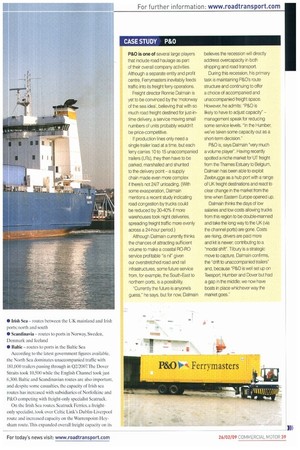Unaccompanied trailer freight is a steadily growing industry, as hauliers
Page 38

Page 39

Page 40

Page 41

If you've noticed an error in this article please click here to report it so we can fix it.
in the UK and across the Continent look to cut their costs and save themselves from going under in these difficult economic climes.
The first regutar RO-RO (roll-on roll-off) ferry service crossing began from Dover in 1953, which opened up the possibility of pan-European road haulage from the UK, and the prospect of unaccompanied trailer (UT) traffic.
Despite the parallel rise of shortand long-sea container traffic. RO-RO ferries have remained popular, and unaccompanied trailer traffic has grown steadily, particularly on Irish and North Sea crossings.
Shop around and it's possible to send a UT from British ports to North America, Cyprus and even Nigeria. but, broadly speaking, analysts tend to break the UK market into five route sectors: • Near continent of Europe Belgium. Netherlands and German North Sea coast ports • Channel — (eastern and western) connecting to ports in France. Spain and Portugal
• Irish Sea routes between the UK mainland and Irish ports: north and south • Scandinavia routes to ports in Norway, Sweden, Denmark and Iceland • Baltic routes to ports in the Baltic Sea According to the latest government figures available. the North Sea dominates unaccompanied traffic with 181,000 trailers passing through in 02/2007.The Dover Straits took 10500 while the English Channel took just 6.300. Baltic and Scandinavian routes are also important. and despite some casualties, the capacity of Irish sea routes has increased with subsidiaries of Norfolkine and P&O competing with freight-only specialist Seatruck.
On the Irish Sea routes. Seatruek Ferries, a freightonly specialist, took over Celtic Link's Dublin-Liverpool route and increased capacity on the Warrenpoint-Ileysham rotue.This expanded overall freight capacity on its Irish Sea routes threefold from 90,000 to 270,000 units per annum.
Alistair Eagles, Seatruck's deputy managing director, says: "Our strategy for the future is founded on the view that too much Irish Sea freight currently well over 40% moves on a driver-accompanied (DA) basis. Increasingly, our clients recognise the major cost benefits of switching to unaccompanied movements. More than 40% of trailers on these routes are driver-accompanied, hut Seatruck believes hauliers will increasingly turn to unaccompanied services because they are cheaper."
Due south On the southern North Sea route, P&O Ferries has commenced a RO-RO service between the Port of Tilbury and Zeebrugge in Belgium, with two round trips per day. Ronny Daelman, P&O freight director, says: "The strengths of both Tilbury and Zeebrugge should be recognised in terms of location and ease of access. We believe this route is well placed to capitalise on forthcoming levels of demand for unaccompanied freight space."
Overall declining volumes, a need to contain costs and the changing patterns of road transport from Eastern
Europe seem to point to a likely increase in UTs as operators consider if they really need to send a driver and unit across the water.
A straw poll of members by the British International Freight Association (BIFA), especially for this feature, confirmed both DA and UT traffic volumes are down by around 5-6% although it cautions this could be influenced by seasonality as much as recession. Contrary to some ferry operators' opinions, BIFA members expected this to reinforce DA traffic rather than cause a flight to UT. "We don't see a switch," says policy group manager Paul Young. Only if cost is a major factor will they consider changing" •
Contacts
P&O: ,v.poferriesfreig ht.com Norfolkline: www.norfolktinefreight.com Seatruck: www.seatruckferries.com Heriot-Watt University: ww.smt.hmaculqlogisticsi pdf/Marine2,; British International Freight Association: www.Bifa.org rThe UK's island status means multi-modal connections with the rest of Europe are essential, and currently Eurotunnel doesn't carry UT traffic. Consequently, freight ferry operators need to be large, well-capitalised organisations with deep pockets capable of sustaining their route infraConclusion
structure in bad times so as to maintain profitable traffic volumes in good times.
UT traffic is a price-sensitive market, simply reducing ferry frequency when the market dips quickly threatens prof it margins, and hiking costs is no answer when customers are suffering from the credit crunch too. Whereas embattled road hauliers may consolidate to survive, this tactic is less easy to achieve in shipping, and is likely to attract the attention of monopolies' watchdogs and politicians. Better perhaps to try to grow demand, and in this respect Seatruck asks crucial questions applicable to all crossings: Do your trailers really need to be accompanied? Might unaccompanied be cheaper? Have you considered swapping?
In the meantime, from a haulier's perspective, some crossings may have less frequent sailings, but pricing is likely to remain extremely keen.
















































































































































